The Bagpipe Society
Swedish Bagpipes - A Performer's Perspective
Let’s face it: As bagpipes go, the Swedish one doesn’t strike you as particularly impressive at the first look. In its most basic form, it really boils down to the essence of a bagpipe without bells and whistles: There is a leather bag, a blowpipe, one cylindrical chanter and one short, stubby drone (traditionally tuned to the unison of the chanter’s lowest melody note). Both the chanter and the reed are fitted with a single reed, giving the instrument its rather nasal – and typical – sound. Traditionally, only one scale is possible since the chanter lacks chromatics (a feature which has been added later, as we shall see) . Now, all this being said… the instrument definitely possesses a unique quality and whatever it is, its mystical allure continues to draw in people. Thus, today we find quite a few makers in both Europe and USA, offering many different variations on this rather basic theme. Personally, I have been playing and performing the thing for over 20 years now, and I have seen the number of players and makers grow at a slow but steady rate.
For an excellent overview of the background and history of the Swedish pipes, I urge you to visit Olle Gällmo’s website at http://www.gallmo.se. What I’d like to share with you are some of the stories and experiences I’ve had over the years as a Swedish piper. Incidentally, if you weren’t too familiar with the Swedish bagpipes before reading this article, don’t feel bad – neither are the Swedes. One would expect the message to have sunk in by now (it’s been almost 40 years since the revival in the 1970’s, after all) but say that you play the bagpipes to the average Swede and he or she is bound to ask you where your kilt is and/or cover their ears in mock horror. Maybe in another 40 years’ time the bagpipe awareness will have been raised to an acceptable level…
The very first time I heard a Swedish bagpipe was in the early 90’s, in the form of an LP (remember those?) with a music teacher and folk/early music aficinado from the island of Orust in west Sweden; Ingvar Lundsten. He had recorded a whole album of ancient and obscure instruments, of which the Swedish bagpipe took front and centre. I clearly remember hearing the first track of the LP: “Västgötavalsen” (The West Gothia Waltz).
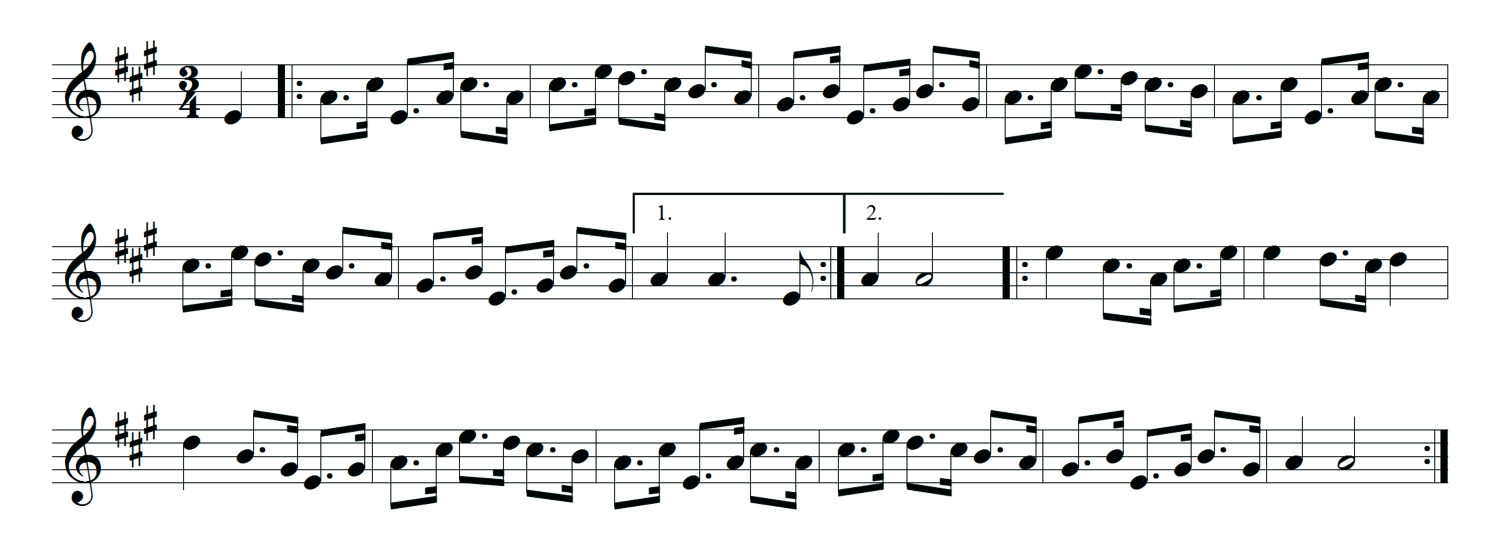
Incidentally, this seems to be one of those tunes shared by the cultural DNA of many, if not most, musical cultures. I’ve played this tune for Germans, Czechs, Scots, Englishmen, French, Canadians, Danes, Belgians… and everyone says it reminds them of a similar tune from their place! Well, since Douglas Adams claimed that every culinary culture has their own version of meatballs, maybe the same goes for music! So, while Västgötavalsen may not be “typically Swedish” (whatever that is), another tune from the same source certainly sounds more exotic.
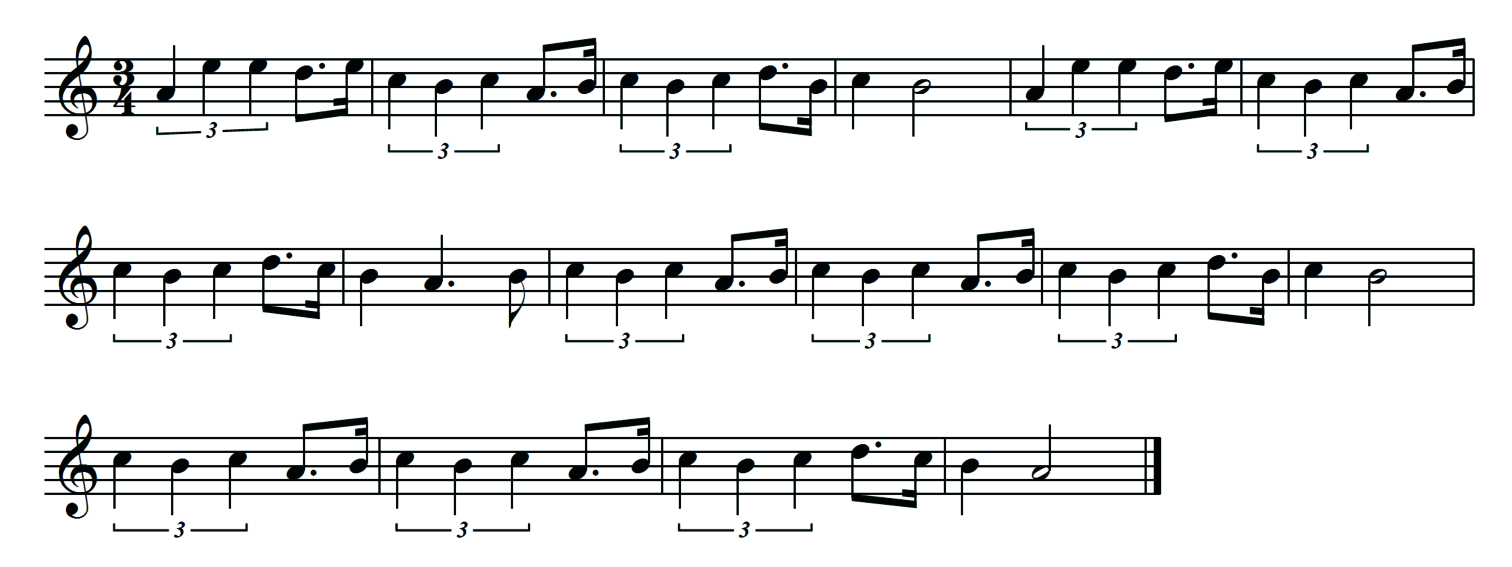
This tune, “Skomakarpolska” (Shoemaker’s Polska) has for many years been a staple of mine at workshops and bagpipe classes, especially to students not already familiar with Swedish music. It contains some typical elements and is not very difficult to play – except for that rhythmic thing that is going on in the first half of most bars. What is happening there? Well, without getting too technical about it, this tune is a “polska”, one of the most – if not the most – popular dance forms in traditional Swedish music. Please note that it should be “polska” with an “s”, NOT “polka” which is something entirely different! (It has been said that the difference is that while a polka would be very hard to dance if you suffer from a severe limp, this would actually help you when learning the polska!) Most polskas are notated in a 3⁄4 time signature, but they are more often than not played in a different way. The “secret” is feeling the beat on bar 1 and 3, which is how Swedish musicians usually tap their feet while playing. The interesting thing is that the quaver triplet creates a sort of “upbeat” just before the second beat, infusing the tune with that Nordic allure… (side note: The polska is actually found in all the Nordic countries – and of course even beyond; in Europe you find its cousin twice removed, the Polonaise – but only the Swedes embraced it completely and made it their most treasured keepsake.) In a tune like this, it is very important to get the “bounce” right – a common fault is to play the polska too heavy handed; it really needs a light and fluent touch. The “bounce” is where the Swedish pipe excels, since the single reed together with the half-closed fingering allows for quick octave jumps like this (the first bar):
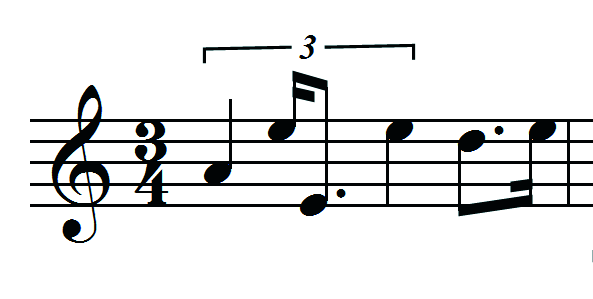
…and since the drone is tuned to the unison (NOT one octave below as is more common in other pipes) of the bottom E note, it comes out as this.
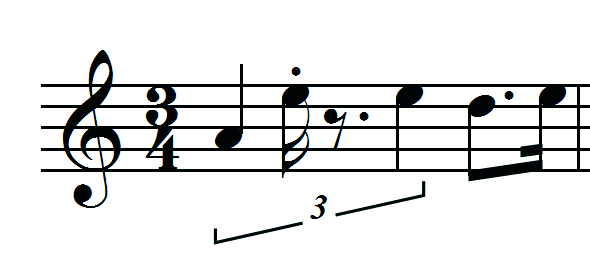
…not only making articulation possible but actually inviting it! Personally, I have appropriated parts of this playing style to French and Scottish-style pipes as well, which I think works very well! I definitely think its unique repertoire is a large part of the popularity of the Swedish pipes. I remember playing this tune at my first concert in Scotland; I had joined a Scandinavian pipe band who went there to compete and I was invited along to show the Swedish pipes. Needless to say, the Great Highland Bagpipe and the Swedish bagpipe occupy different ends of the spectrum and I was eager to find out the Scots’ reaction to our “wee Viking pipe” as it became known. Another moniker turned out to be the “Hangover Pipes” since the Scots thought its comparatively mellow sound made it perfect for that purpose!
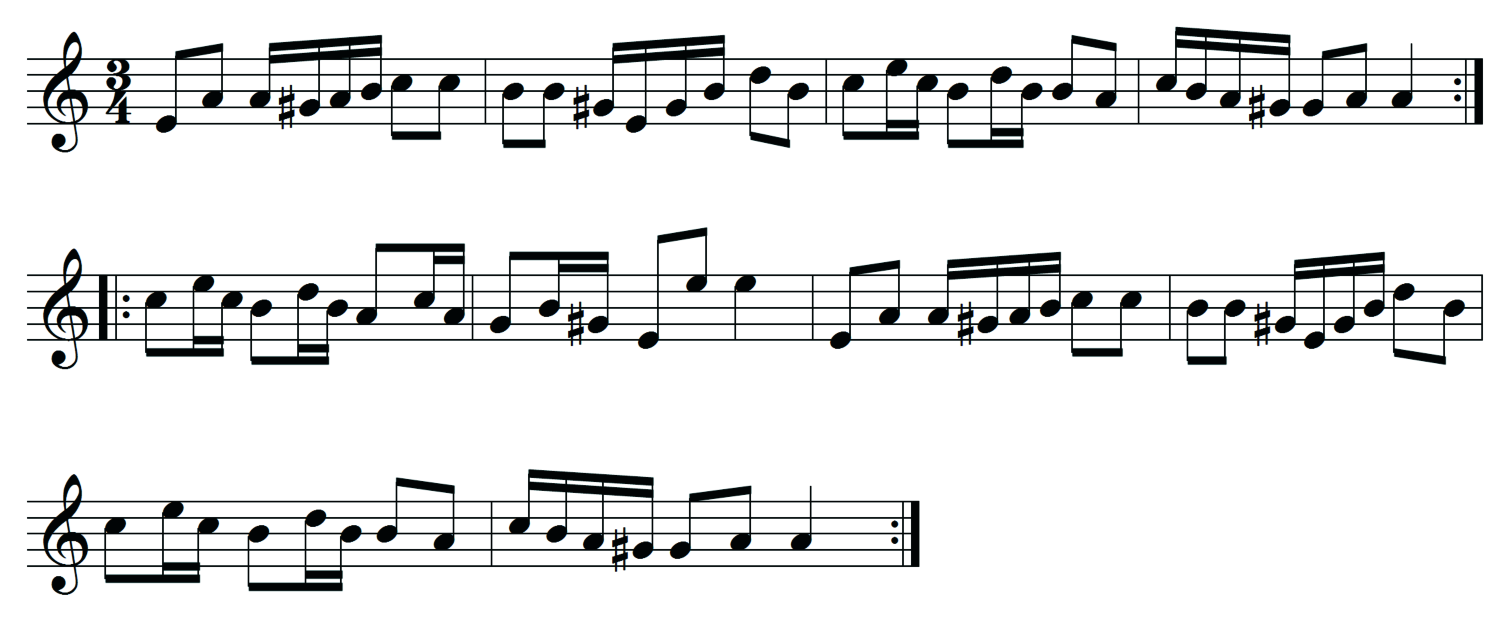
Now here is another, quite different, tune – also a polska but a more “straight” version, known as “slängpolska”. While the polska is accentuated on the first and the third beat, the slängpolska’s rhythm is felt evenly across all three beats; one should count simply “one-two-three”. The key is again A minor, in which most of the extant instruments (now in museums) seems to have been tuned to. Interestingly, this was described as “the haunting Swedish scale” by an post order store in America that sold Swedish pipes way back in the 80s. Nothing particular Swedish about it, it is just a plain minor scale.
I was taught this tune by some fellow musicians from Skåne (in the south of Sweden, where I live now) as part of the repertoire when we played at the amazing bagpipe festival in southern Germany, “Sackpfeifen in Schwaben”. It takes place every three years and is a wonderful experience – if you like bagpipes, that is. (Which I assume you do, since you’re reading Chanter!) Of course Germans don’t do things half-heartedly, and so the final concert of the festival was called “Acht Stunden Europäischer Dudelsackmusik” which translates as “Eight Hours Of European Bagpipe Music”. It sounds like heaven or hell, doesn’t it - depending on your inclination, and it actually turned out to be more like twelve hours since very few of the performing groups kept to their allotted time slot (a very generous 15 minutes).
Finally, I’d like to tell you about another aspect of the Swedish pipes – namely its perfect role as an accompanying instrument. Because it is rather soft and mellow, it mixes very well in an ensemble sound, and we used it quite much alongside fiddles, Nyckelharpa, accordion, guitar, even flutes, in my own bands Dråm and Svanevit, as well as when I played in Faust, together with the German- Swedish instrument maker and eponymous musician Alban Faust. Alban is one of the most prolific makers of the Swedish pipes, and the credit of creating the modern instrument must at least in part go to him. The original specimens in museum collections are all rather crudely made, usually of birch or pine, with the holes and bore not drilled, but simply burned out with a red-hot poker. When Leif Eriksson started to build bagpipes again in the 1970s (the last traditional player of a lineage had passed away in 1949), he based his design on the old instruments, and as far as I know Alban was one of the first to adapt and update the design to include materials such as plum, walnut, rowan…
Also, a second thumbhole (in the French style) was introduced to extend the range somewhat. Nowadays, you can have a bellows-blown Swedish bagpipe with four drones and keyed chanter, begging the question of whether it still is “Swedish”? (Alban, who makes this wonderful monster, actually calls it “The Northern Uilleann Pipes” – a bit tongue-in-cheek..
But back to the idea of the Swedish bagpipe as an accompanying instrument. One of its best uses is to play the harmony voice to a conical pipe (Border or French, for example) –both its softer sound and deeper range (since it’s cylindrical with a single reed, it sounds one octave below a conical, double-reed instrument. Here is an example from my Faust days, in G minor this time – and of course it’s another polska:
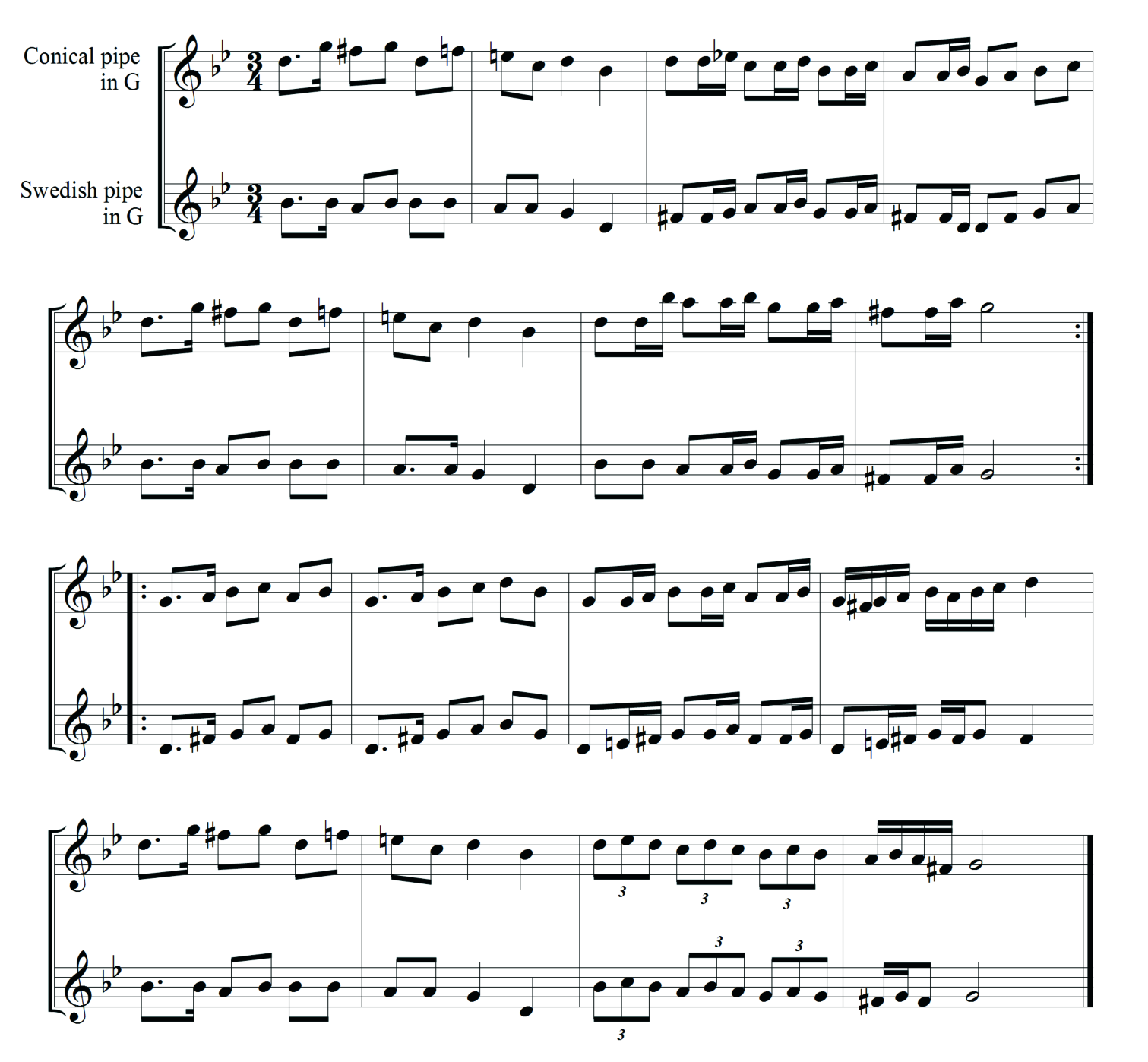
A few more things to note here: The difference of one whole note step from A to G changes the timbre quite a lot, and it works even better together with a conical pipe. Also, the naming changes because with Swedish pipes, we take the three-finger note as our starting point (G on what would be called a “D” pipes) and so a Swedish “G” pipe has the range D-d. Why is this? Simply tradition, and also because a vast number of tunes fit this range! We even find tunes that are called “Bagpipe tune” that aren’t playable on the pipes; they survived by means of fiddlers, who imitated drone instruments in their playing! And today, the circle is complete since we have used those tunes again to learn more about the old bagpipe repertoire…
With this, I thank you for your interest and hope to see you around – why not on the polska dance floor? :-)
- Data Processing Notice (GDPR)
-
@BagpipeSociety on X (formally known as Twitter)
-
TheBagpipeSociety on Instagram
-
 BagpipeSociety on Facebook
BagpipeSociety on Facebook
Something wrong or missing from this page? Let us know!
